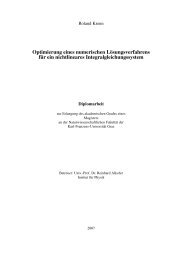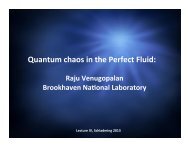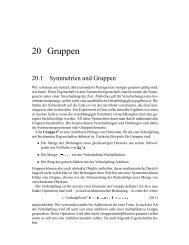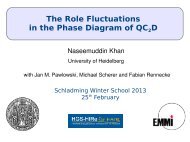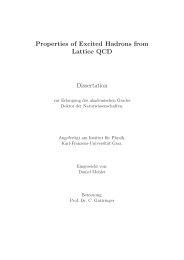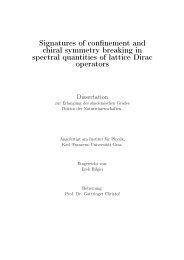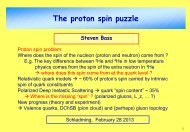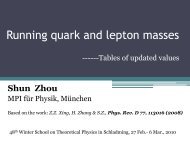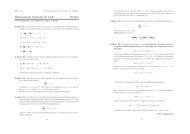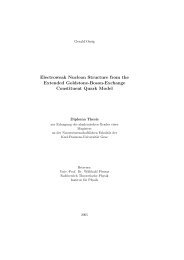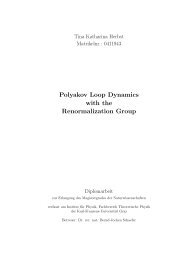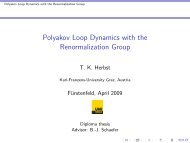The QCD Quark Propagator in Coulomb Gauge and - Institut für Physik
The QCD Quark Propagator in Coulomb Gauge and - Institut für Physik
The QCD Quark Propagator in Coulomb Gauge and - Institut für Physik
Create successful ePaper yourself
Turn your PDF publications into a flip-book with our unique Google optimized e-Paper software.
Chapter 6. Nucleon Form Factors <strong>in</strong> a Covariant Diquark-<strong>Quark</strong> model 55<br />
• Bag models imag<strong>in</strong>e hadrons as colour s<strong>in</strong>glett bag out of perturbative vacuum with<br />
relativistic quarks <strong>and</strong> gluons.<br />
• Soliton models picture baryons as a localised lump of energy density, which consists of<br />
mesons. One ansatz is the topological soliton, where the baryon number is identified<br />
with a topological w<strong>in</strong>d<strong>in</strong>g number, which is connected to the boundary conditions<br />
for the meson field configurations. An <strong>in</strong>terest<strong>in</strong>g variation are chiral solitons, which<br />
are non-l<strong>in</strong>ear <strong>in</strong>teract<strong>in</strong>g systems of quarks <strong>and</strong> pions.<br />
Most of these models describe static <strong>and</strong> a few dynamic observables quite well on the<br />
usual twenty-percent scale of accuracy. However, none of these can be formulated <strong>in</strong><br />
a covariant manner. A model with this feature could also succeed <strong>in</strong> the <strong>in</strong>termediate<br />
energy regime. Outst<strong>and</strong><strong>in</strong>g observables with an <strong>in</strong>terest<strong>in</strong>g behaviour on such energy<br />
scales are the electromagnetic form factors of the nucleon.<br />
In order to underst<strong>and</strong> the structure of the nucleon large experimental <strong>and</strong> theoretical<br />
effort is undertaken [TW]. An important branch is the exploration of the electromagnetic<br />
structure [ARZ06, PPV06]. Modern, high-lum<strong>in</strong>osity experimental facilities that<br />
employ large momentum transfer reactions are provid<strong>in</strong>g remarkable <strong>and</strong> <strong>in</strong>trigu<strong>in</strong>g new<br />
<strong>in</strong>formation <strong>in</strong> this field [Gao03, BL04]. For an example one need only look so far as<br />
the discrepancy between the ratio of electromagnetic proton form factors extracted via<br />
Rosenbluth separation <strong>and</strong> that <strong>in</strong>ferred from polarisation transfer. This discrepancy is<br />
marked for Q 2 ∼ > 2 GeV2 <strong>and</strong> grows with <strong>in</strong>creas<strong>in</strong>g Q 2 . At such values of momentum<br />
transfer, Q 2 > M 2 , where M is the nucleon’s mass, a real underst<strong>and</strong><strong>in</strong>g of these <strong>and</strong><br />
other contemporary data require a Po<strong>in</strong>caré covariant description of the nucleon. This is<br />
apparent <strong>in</strong> applications of relativistic quantum mechanics, e.g. [B + 02].<br />
In this chapter we <strong>in</strong>troduce shortly such a model, which we ga<strong>in</strong> by reduc<strong>in</strong>g the<br />
relativistic three-quark problem, <strong>and</strong> use it <strong>in</strong> order to calculate nucleon form factors.<br />
<strong>The</strong> formal sett<strong>in</strong>g for such a model was already clarified more than two decades ago<br />
[AT77, Glo83]. In the quantum field theory framework the few-body problem is somewhat<br />
ill-posed, s<strong>in</strong>ce a rigorous treatment should take <strong>in</strong>f<strong>in</strong>itely many degrees of freedom <strong>in</strong>to<br />
account. However, the observed spectrum of mesons <strong>and</strong> baryons advises us that a good<br />
physical description is probably possible us<strong>in</strong>g the constituent quarks as degrees of freedom.<br />
<strong>The</strong>refore we consider matrix elements of three quarks between the non-perturbative<br />
vacuum <strong>and</strong> a bound state with certa<strong>in</strong> observable quantum numbers, which we call wave<br />
functions, <strong>in</strong> order to calculate observables (s<strong>in</strong>ce the <strong>QCD</strong> vacuum is a non-trivial condensate<br />
it conta<strong>in</strong>s sea quarks <strong>and</strong> gluonic fractions). With this conditions the quantum<br />
mechanical formulation of the three-body problem can be adopted <strong>in</strong> the Green’s functions<br />
formulation.



